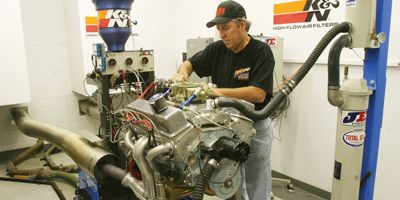
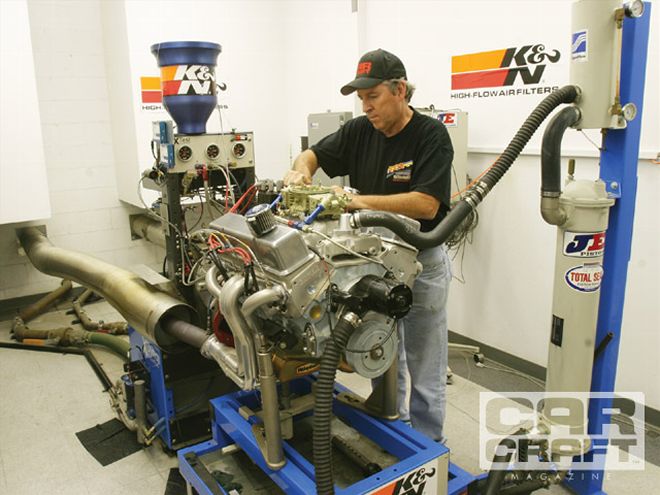 Carburetors are relatively simple devices, but if you can negotiate your way around these Holley circuits, there are many little tricks you can use to improve power without sacrificing mileage or driveability.
Carburetors are relatively simple devices, but if you can negotiate your way around these Holley circuits, there are many little tricks you can use to improve power without sacrificing mileage or driveability.
It's an interesting fun fact that once electronic fuel injection appeared on the scene, carburetors enjoyed significant improvements in technology. Perhaps this is mere coincidence, but the basic Holley carburetor has come further in the last 10 years than it did in previous decades. Despite several premature predictions of this fuel mixer's death, carburetors are more alive than ever. To emphasize how easy they are to tweak, we've run down a few simple tricks that are affordable and fun to do that will pay off in terms of more airflow, a little more horsepower, and perhaps even greater driveability. This is actually several stories rolled into one handy package, so check out our Holley carb mod extravaganza.
Peak TQ Peak HP Avg. TQ Avg. HP Carburetor Holley 650 455 476 428.5 380.4 750 HP Body 456 477 429.8 381.6Simple Swap
The Holley HP carburetors have become some of the best street fuel mixers for car crafters wanting to step up to a true performance four-barrel. One way you can do this is by converting the main body rather than buying a whole new carburetor. We thought we'd combine that idea with another slick little trick we've mentioned before. In looking through the Holley spec book (we know, it's a sickness), we noticed that the 600- and 650-cfm Holley mechanical-secondary carburetors use the same throttle plate as the 750. That means by purchasing a 750-cfm Holley HP main body, you can upgrade a 600 or 650 double-pumper to a 750 for less than $150.00. You can also apply this same HP upgrade idea to a 0-4779 Holley 750 carburetor. Of course, if you want to just step up, Holley offers a Street HP carburetor that is a great way to combine all these features in a carb we really like.
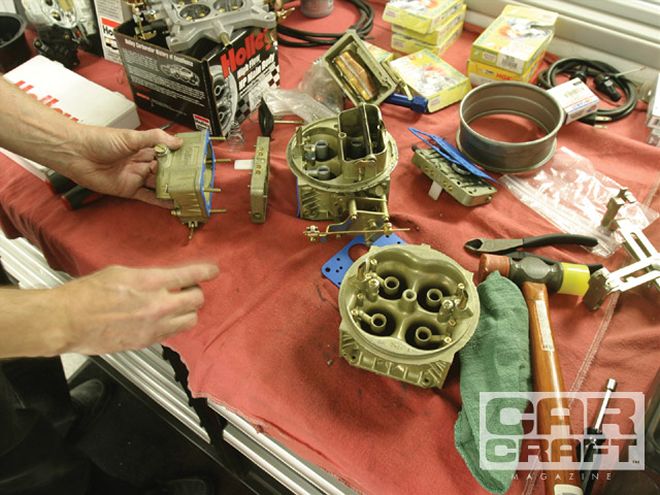 We first baselined the 650 mechanical-secondary carb and were surprised at how much power it made after we increased the jetting for best power. Then it took mere minutes to strip the 650 carb and convert it to the 750 HP main body.
We first baselined the 650 mechanical-secondary carb and were surprised at how much power it made after we increased the jetting for best power. Then it took mere minutes to strip the 650 carb and convert it to the 750 HP main body.
We wanted to put this remake to the test on the dyno. The K&N filter people offered their SuperFlow 902 dyno, so we bolted our 383 small-block to the pump to evaluate exactly what this swap would be worth. This is the engine we tested back in the Sept. '08 issue, built with 9.8:1 compression and a Jay Allen-designed Camshaft Innovations flat-tappet mechanical lifter cam. The top end is a set of 195cc Canfield aluminum heads and an Edelbrock Performer RPM Air-Gap intake, which makes a great near-500hp test engine for carb flogging.
The first step was to test the 650-cfm carb to create a baseline. On the first pull, the power was way down with the little carb, but after a quick jet exercise, the motor cranked off an excellent 476 hp at 6,100, which was right where we left off when the engine ran the last time at Westech. The next step was easy, since all we had to do was swap the small 650's main body for the larger Holley HP. Once the swap was completed and back on the engine, we ran through a couple of jet changes to make sure the engine had all the fuel it wanted. Curiously, the power didn't really change much and neither did the amount of vacuum in the manifold at peak power, indicating that even with this larger carburetor, the measured airflow through the engine only increased about 5 cfm. Since airflow didn't increase, the power remained basically the same. While this move to an HP main body didn't help on our engine, it's clear the restriction to making more power is somewhere else. If we were looking for more peak horsepower, we'd swap to a single-plane intake, but this would probably also diminish midrange torque. Even though we didn't make a ton of power with this conversion, it is still a great way to upgrade a budget-priced 600- or 650-cfm Holley to 750 HP status easily and without spending a ton of money. It doesn't get much easier than this.
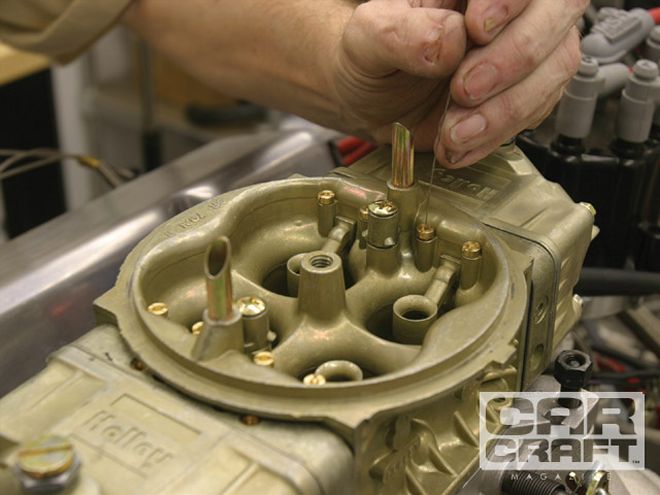
The HP main body comes with replaceable idle and high-speed air bleeds in the top of the carb. We first tried using the original 650 air bleed sizes, but that didn't work. Then we tried the 750 HP high-speed air bleeds and had to reduce them in size from 0.030 to 0.026 inch to get the air/fuel ratio where we wanted it in combination with more jet changes. RapidJet sells a tool called an air bleed fish wire, which is a tiny wire that slips through the bleeds when changing them to prevent them from dropping into the engine.
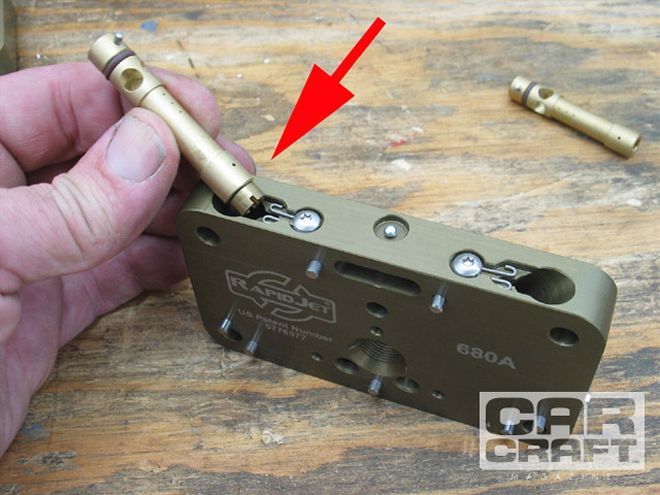 This is what the RapidJet metering block and cartridge system look like. The cartridge slips into the metering block from the top and seals with a single Viton O-ring. The Holley main jet screws into the bottom of the cartridge (arrow) and can be quickly changed by yanking the cartridge-no more spilling fuel and removing the fuel bowls.
This is what the RapidJet metering block and cartridge system look like. The cartridge slips into the metering block from the top and seals with a single Viton O-ring. The Holley main jet screws into the bottom of the cartridge (arrow) and can be quickly changed by yanking the cartridge-no more spilling fuel and removing the fuel bowls.
RapidJet Conversion
Over the years, there have been several companies that have offered quick-change jet conversion kits for the Holley carburetor. Recently, the RapidJet folks showed us a slick Holley conversion system the company has been working on for years. What intrigued us about the RapidJet metering block is that this system offers much more than the ability to change jets in the carburetor without removing the float bowls. The RapidJet system starts with a hard-anodized billet metering block (that comes in three different colors) that incorporates a cartridge that is easily accessible from the top of the carb once the air cleaner is removed. Once you've removed the cartridge, reinsert it upside down in the metering block, and the standard Holley jet can then be easily changed. The hard anodizing means the block is safe for all different types of fuels, including alcohol. All the passages in the block and cartridges are line of sight, which means there are no little hidden corners that can trap dirt.
The most interesting part of this kit is that all the metering orifices found in a typical Holley metering block are contained in the RapidJet cartridge. This includes the idle feed restrictor (IFR), the power valve channel restrictor (PVCR), as well as the multiple main well emulsion holes. This places all the fuel and air metering devices in one convenient location where they can be easily swapped to fine-tune the carburetor to your specific application.
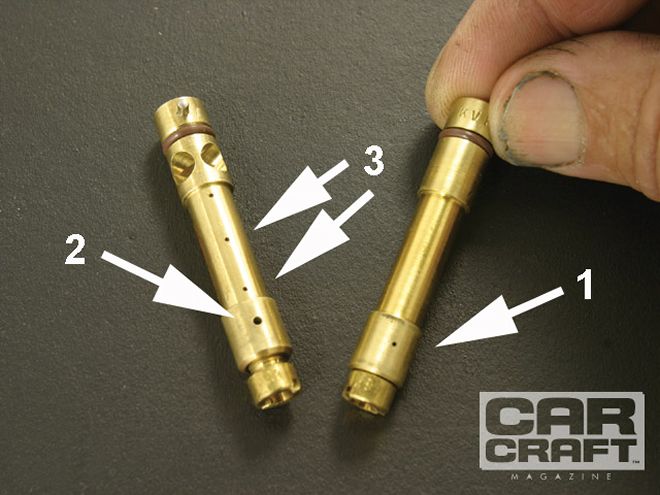 The bottom hole (arrow 1) in the cartridge is the idle feed restrictor and is located on the opposite side of the cartridge from the power The bottom hole (arrow 1) in the cartridge is the idle feed restrictor and is located on the opposite side of the cartridge from the power valve channel restrictor (PVCR), which is arrow 2. Arrow 3 indicates the two main well emulsion holes. valve channel restrictor (PVCR), which is arrow 2. Arrow 3 indicates the two main well emulsion holes.
The bottom hole (arrow 1) in the cartridge is the idle feed restrictor and is located on the opposite side of the cartridge from the power The bottom hole (arrow 1) in the cartridge is the idle feed restrictor and is located on the opposite side of the cartridge from the power valve channel restrictor (PVCR), which is arrow 2. Arrow 3 indicates the two main well emulsion holes. valve channel restrictor (PVCR), which is arrow 2. Arrow 3 indicates the two main well emulsion holes.
For our test, we decided to use the same Holley we had just converted into a 750 HP and then swap the primary and secondary metering blocks to the RapidJet system. To begin with, we carefully measured and then replicated as closely as possible the original Holley metering hole sizes. In discussing this, we anticipated that the first test with this conversion might go rich because the billet metering blocks utilize a significantly larger 0.213-inch-diameter main well compared with a typical Holley block's 0.140 inch. Because the main well is larger, it will tend to move fuel more easily.
The baseline Holley main metering blocks employ only two main well emulsion holes measuring 0.027 inch in diameter. In addition, the PVCR measured 0.039 inch in the primary and was blocked off in the secondary, while the IFR measured 0.035 inch. Once replicated, we ran the engine again to see if the fuel curve really changed.
While the air/fuel ratio did not indicate that the engine was rich, after a couple of minor changes, we concluded that the engine wanted less fuel, especially at lower engine speeds.
We leaned out the main jets, but this left the top of the curve too lean. Rather than messing with the high-speed air bleeds, we decided to block off one of the two emulsion holes, which would tend to make the engine run richer at the top end of the rpm scale. Usually, a jet change will help one spot in the curve but hurt the rest of the curve, so jetting changes become a matter of compromise. By using the RapidJet cartridge to help us tune more quickly, we were able to home in on an extremely accurate curve for this engine quickly. Much of this was because we didn't have to pull the fuel bowls off each time we wanted to make a change. This alone saved hours on the dyno.
As you can see from the results, all this effort paid off with a much more stable fuel curve, and the engine made more power. All told, our test was a rapid success.
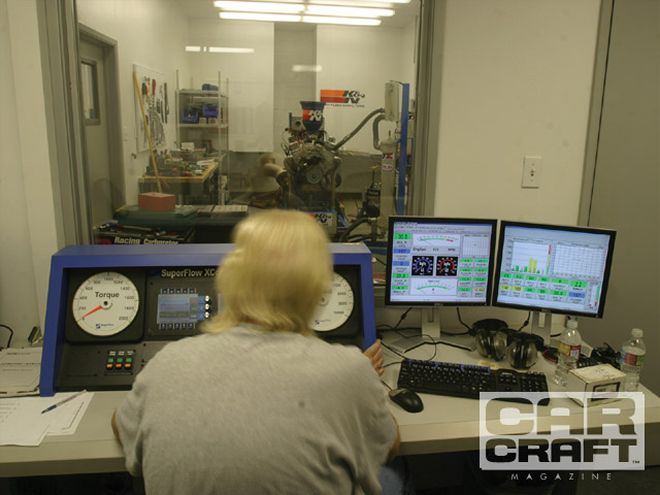 John Reedy ran the SuperFlow 902 dyno for us and helped with the carb thrashing. The K&N dyno facility is first rate and usually filled with the thunder of big-inch Rat motors.
John Reedy ran the SuperFlow 902 dyno for us and helped with the carb thrashing. The K&N dyno facility is first rate and usually filled with the thunder of big-inch Rat motors.
Dyno Test
Here's where our testing became interesting. Ultimately, we discovered that this engine wanted less fuel to make more horsepower with the air/fuel meters peaking at around 13.3:1. As the power kept increasing, the spark plugs all looked good. Most of the change in power during this test can be attributed to the jet change (two leaner in the front and four in the rear), since that has the effect of lowering the entire curve but really doesn't affect the shape of the curve.
In an attempt to alter the shape of the curve, we first eliminated the lower of the two emulsion holes in the cartridge, leaving only one 0.028-inch hole in each cartridge. Then we calculated the area of that 0.028-inch hole and converted it into two 0.020-inch holes (which calculates out at 3 percent larger) and found that this combination reshaped the curve, adding a little more fuel at the top. By using two holes, we think this tended to stabilize the fuel curve over the wider rpm band. This is a difficult thing to accomplish since we're looking at an overall rpm band of almost 3,000.
The best way to evaluate the carburetor modifications is to pay attention to the changes in fuel flow. The biggest changes occurred when we changed jets, but we noted that the fuel flow change was not consistent all the way through the rpm band. The most drastic alterations in fuel flow occurred at the bottom with the jet change. When we modified the emulsion hole size and position in the cartridge, we were able to effectively richen the top end of the curve. At 3,200 rpm, we reduced the fuel flow by 27 lb/hr from 146 to 119, which is an 18 percent change. But at 6,100 rpm, we reduced the fuel flow only 17 lb/hr, which is only a 7 percent change.
As you can see by the power numbers, this half-day's worth of playing on the dyno was equivalent to about 7 lb-ft and an almost 6hp average. More importantly, these improvements show what can be done with a slightly more sophisticated approach to carburetor tuning.
Click here for the Holley carburetor tuning dyno test results
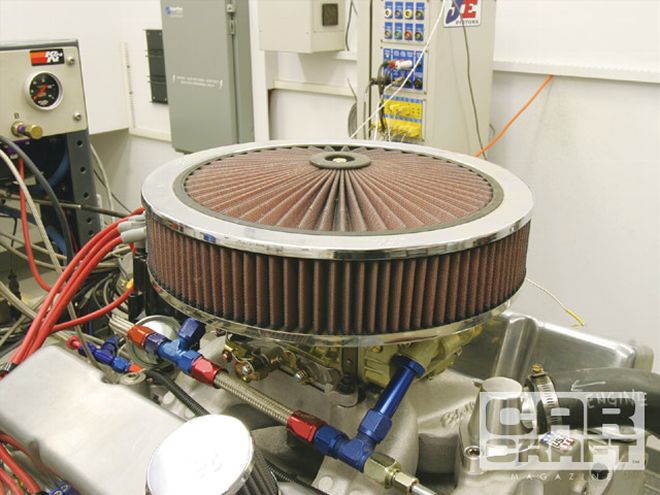 Just adding a K&N X-stream lid to a 14x3-inch filter was worth a 4hp average over a paper filter.
Just adding a K&N X-stream lid to a 14x3-inch filter was worth a 4hp average over a paper filter.
K&N Air Filter Test
While we had the use of K&N's dyno, we also thought we'd do a quick air filter test, something we haven't done for quite a while. We used the same carb we had just tuned with the RapidJet, starting first with no air cleaner and without the SuperFlow air turbine on the carburetor. It's worth noting that our baseline numbers were not the same as the final number used in the previous RapidJet test, since we noticed a slight loss of power when the air turbine was removed.
Most everybody knows the story about the K&N filter, which uses oil-impregnated cotton gauze to filter air efficiently. As a matter of fact, the dirtier the filter becomes, the more efficiently it removes dirt from the air. First, we tested a bargain-basement 14x3-inch paper filter, then a K&N filter of the same size, and then the addition of a K&N X-Stream filter lid. The best combination was the K&N filter with the X-Stream lid. We also tested a taller, 4.5-inch filter element, which surprisingly lost a little bit of power. Of course, had we spent as much time tuning the engine for that filter as we did with the air turbine, we think that slight amount of power would have returned. Basically what we found was that our engine preferred a flat air filter base with an X-Stream lid and the shorter 14x3-inch filter. If you compare the X-Stream lid Test 4 against the paper filter Test 2, you can see the K&N filter and lid combo was worth an average of 5 lb-ft and 4 hp. That's pretty good for a simple air filter swap.
Click here for the air filter test results
Parts List Description PN Source Price Holley 650 mech. sec. carb 0-4778 {{{Summit}}} Racing $349.75 Holley 750 HP main body 134-300C Summit Racing $131.95 Holley 750 Street HP carb 0-82751 Summit Racing $479.95 RapidJet metering block kit 680A RapidJet $149.95 RapidJet cartridge custom RapidJet $24.95 K&N 14x3-inch filter E-1650 Summit Racing $47.95 K&N 14-inch X-Stream lid 66-1401 Summit Racing $68.99 K&N X-Stream filter assembly 66-3040 Summit Racing $142.95 K&N oil filter, SBC HP-3002 Summit Racing $10.95